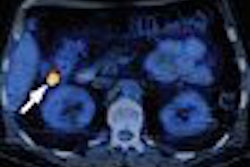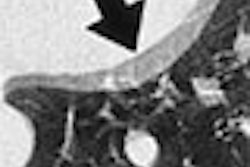Three-dimensional endoluminal views of colonic polyps can be measured more accurately than corresponding 2D multiplanar reconstructions (MPRs), according to a report in the September issue of Radiology.
The study compared histological measurements of polyps removed from 10 patients at colonoscopy with virtual colonoscopy images of the same polyps acquired before polypectomy. A separate arm of the study measured artificial polyps of known sizes in a phantom, taken from 2D and 3D from CT data.
The research team included Dr. Perry Pickhardt and colleagues from the University of Wisconsin Medical School in Madison, and Dr. Elizabeth McFarland from the Washington University School of Medicine in St. Louis.
"Lesion size is perhaps the single most important feature of a polyp detected at computed tomographic (CT) colonography (or virtual colonoscopy) because it serves as a rough surrogate for histologic features, and therefore dictates both the clinical importance of the polyp and patient care," the group wrote (Radiology, September 2005, Vol. 236:3, pp. 872-878).
Despite the importance of polyp size in patient management, however, there is considerable uncertainty regarding the accuracy of polyp measurement in the published data, which consist mainly of 2D views. In their study, the researchers sought to compare the two types of measurements in a small number of patients and from polyps of known sizes in vitro.
"Although some experts have recommended that all three standard orthogonal planes from the 2D multiplanar reformations (MPRs) be used for determining the largest or 'optimized' 2D polyp diameter, most published articles have not specified whether this was done in their methods section," the group wrote. "Despite this reliance on 2D polyp measurement, we are not aware of any published results that confirm the accuracy of this approach."
The measurement of CT data from 3D views, although its accuracy is also unproved, offers the potential for more accurate measurement because the vantage point for maximizing polyp dimensions can easily be optimized, the group stated.
The clinical portion of the study examined 10 patients (five men, five women; ages 50-64, mean age 56.3) who underwent virtual colonoscopy, followed by conventional colonoscopy and polypectomy. A calibrated linear probe (considered more accurate than visual estimation, open biopsy forceps estimation, or ex vivo measurement) was used to measure the resected polyps and compare them with the 'optimized' 2D and 3D CT data measured on a single commercially available system (V3D-Colon, version 1.2, Viatronix, Stony Brook, NY).
The 2D measurements included transverse and coronal views in the phantom (the sagittal view was deemed redundant in the phantoms due to their symmetry), and transverse, coronal, and sagittal views in the clinical cases. In the latter, the longest measurement obtained was considered the 'optimized' 2D measurement, and used to compare with the 3D measurement.
"The 2D MPR measurements were obtained with electronic calipers by using the 'polyp' window standard to the CT colonography system used (window width 2,000 HU, window level 0 HU), with mandatory zoom magnification," the team wrote. The readers had been carefully trained, and were instructed to measure the longest available linear dimension, but to avoid including the stalks of pedunculated lesions in their measurements.
Following cathartic cleansing and colon insufflation, virtual colonoscopy images in the 10 patients were acquired on a four-detector LightSpeed Plus scanner (GE Healthcare, Chalfont St. Giles, U.K.) at 120 kVp, 100 mAs, 3-mm effective section thickness, 1-mm reconstruction interval, 0.5-sec gantry rotation, and table speed of 15 mm/sec.
The polymethyl acrylate colon phantom contained an air-filled sealed cylinder with four acrylic spheres attached to the inner cylinder to simulate polyps. All of the phantom CT images were acquired on a 16-slice Sensation 16 scanner (Siemens Medical Solutions, Malvern, PA), calibrated to 120 kVp, 100 mAs, 3-mm effective section thickness, and 1-mm reconstruction interval.
Results from the patient data showed that the linear measurement error -- the difference between actual measurements and CT data -- was significantly larger with the 2D displays rather than the 3D endoluminal view (p < 0.5). The pooled measurement errors between actual and CT-measured polyps were 1.6 mm ± 0.8 (standard deviation) for the 2D transverse view, 1.4 mm ± 0.7 for 2D coronal, and 0.8 mm ± 0.5 for the 3D endoluminal displays. Optimization to find the longest linear 2D measurement made less difference in the phantom studies due to polyp symmetry, the group noted.
The results also showed systematic and significant underestimation of polyp sizes in 2D measurements, though the phenomenon also occurred less extensively with 3D.
"The 2D MPR views led to an underestimation of actual polyp size for 78 (98%) of the 80 individual measurements, whereas 23 (58%) of the 40 individual 3D measurements were lower than the actual size," the group wrote.
In the colon phantom measurements, 3D endoluminal view measurements were again more accurate. The pooled errors were 4.4 mm ± 3.5 for 2D transverse measurements, 3.8 mm ± 3.3 for 2D coronal, 4.6 mm ± 3.0 for 2D sagittal, and 1.9 mm ± 1.6 for 3D endoluminal displays, according to the authors.
However, although the 3D endoluminal view measurements were still more accurate than the 2D 'optimized' measurements when the latter were considered a separate category, the differences were not statistically significant (p = 0.2).
The 2D coronal projection produced the largest measurement in five cases, the 2D sagittal projection in four cases, and the 2D transverse measurement in just one, the authors noted. In 82% of the cases, the "best" 2D view chosen by the readers corresponded to the largest measurement.
Overall, the 2D MPR views underestimated polyp size in 110/120 (92%) of the 2D measurements. The 3D measurement underestimated polyp size in 28/40 (70%) of individual measurements, and as stated the errors were larger with 2D.
"This discrepancy between 2D and 3D measurements can be substantially reduced by optimizing the 2D MPR measurement, underscoring the importance of optimizing 2D measurement," the authors wrote.
The size underestimation with 2D appears to be principally a result of the standard orthogonal MPR planes not being aligned to the long axis of the polyp, they wrote, adding that window width and level used for 2D visualization is a second major factor contributing to the underestimation of polyp size.
"This effect can be further exaggerated with soft-tissue windows, but can be reversed by widening the window width and/or lowering the center level," Pickhardt and colleagues stated. "However, use of the 3D rendering technique with the CT colonography (VC) system we evaluated not only appeared to minimize this effect, but also may have actually led to slight overestimation of size in some cases. The potential for size overestimation on 3D views needs to be considered, particularly for lesions near a critical size threshold."
The 2D transverse view is likely a suboptimal measurement method, having been seen as the optimal approach in only one case in the study, Pickhardt and colleagues wrote. Many other pitfalls exist in polyp measurement, they added, such as the concept of not including the stalk when measuring nonpedunculated lesions, and the tendency of some polyps to retain a thin barium coating after fecal tagging that may increase their apparent size. And the in vivo measurement method is an imperfect reference standard for polyp sizes, though it is the best one currently available.
Finally, the wide differences in the performance of different 3D endoluminal viewing systems make it difficult to generalize the V3D-Colon results to other settings, the team wrote. On the other hand, the accuracy of 3D systems in general may be aided by the future development of polyp volume estimations, they wrote.
The team concluded that 3D measurements were significantly more accurate than 2D overall.
"For polyps located in poorly distended segments, 2D measurement may be more feasible, whereas elongated polyps situated on complex or thickened folds may be better assessed with 3D views," they wrote of their experience. "To reduce the gross underestimation of polyp size with 2D measurement, the optimized (largest) 2D MPR value should be ascertained and reported. For polyps that border a critical size threshold, we recommend careful consideration of both the 3D endoluminal and the optimized 2D MPR measurements."
By Eric Barnes
AuntMinnie.com staff writer
September 6, 2005
Related Reading
VC experts have an edge over less experienced readers, March 8, 2005
Debate over 2D versus 3D VC reveals subtle differences, January 21, 2005
Group credits 3-D reading for best-ever VC results, October 15, 2003
Virtual colonoscopy: 2-D vs. 3-D primary read, June 3, 2002
Copyright © 2005 AuntMinnie.com



















